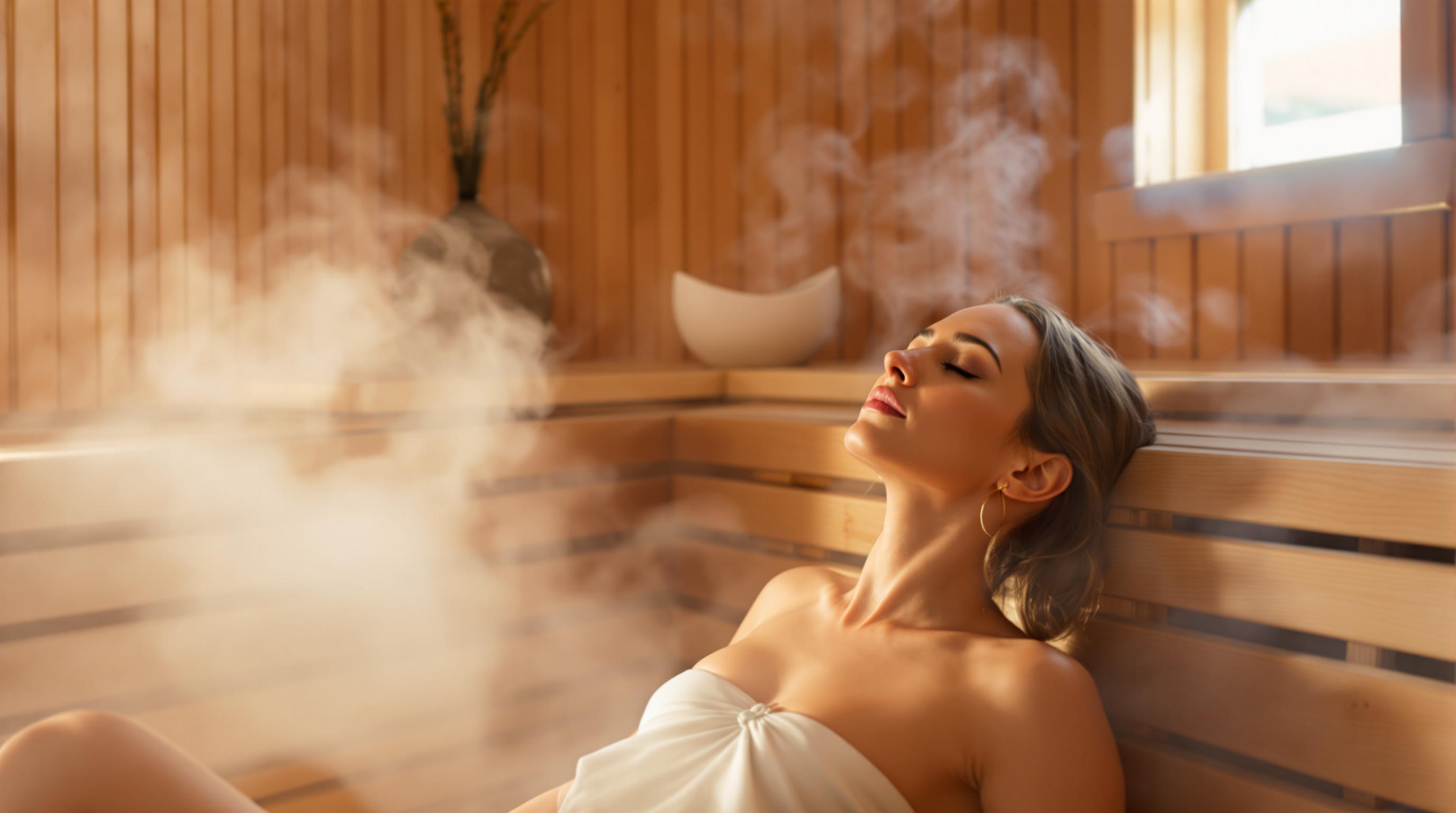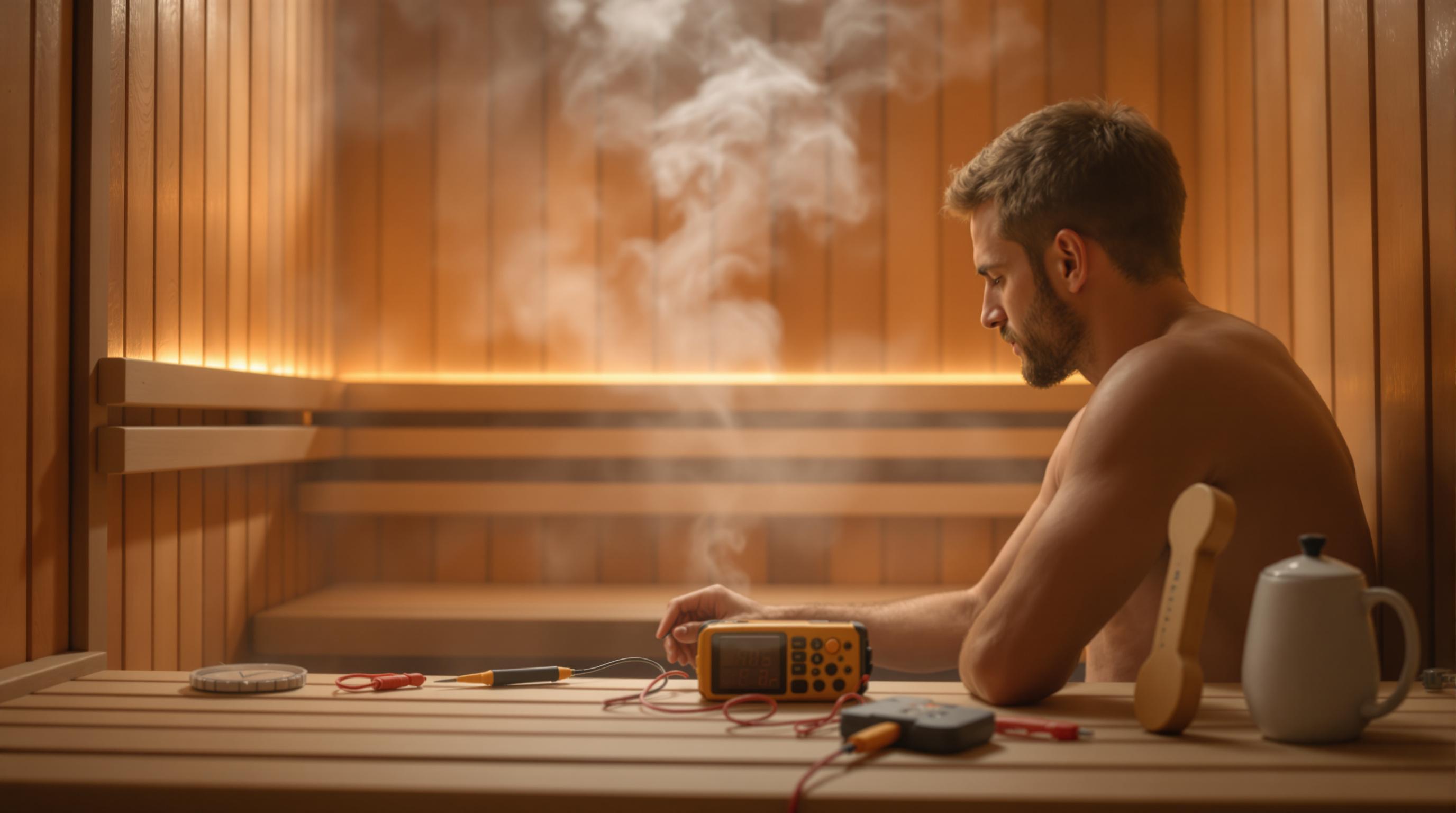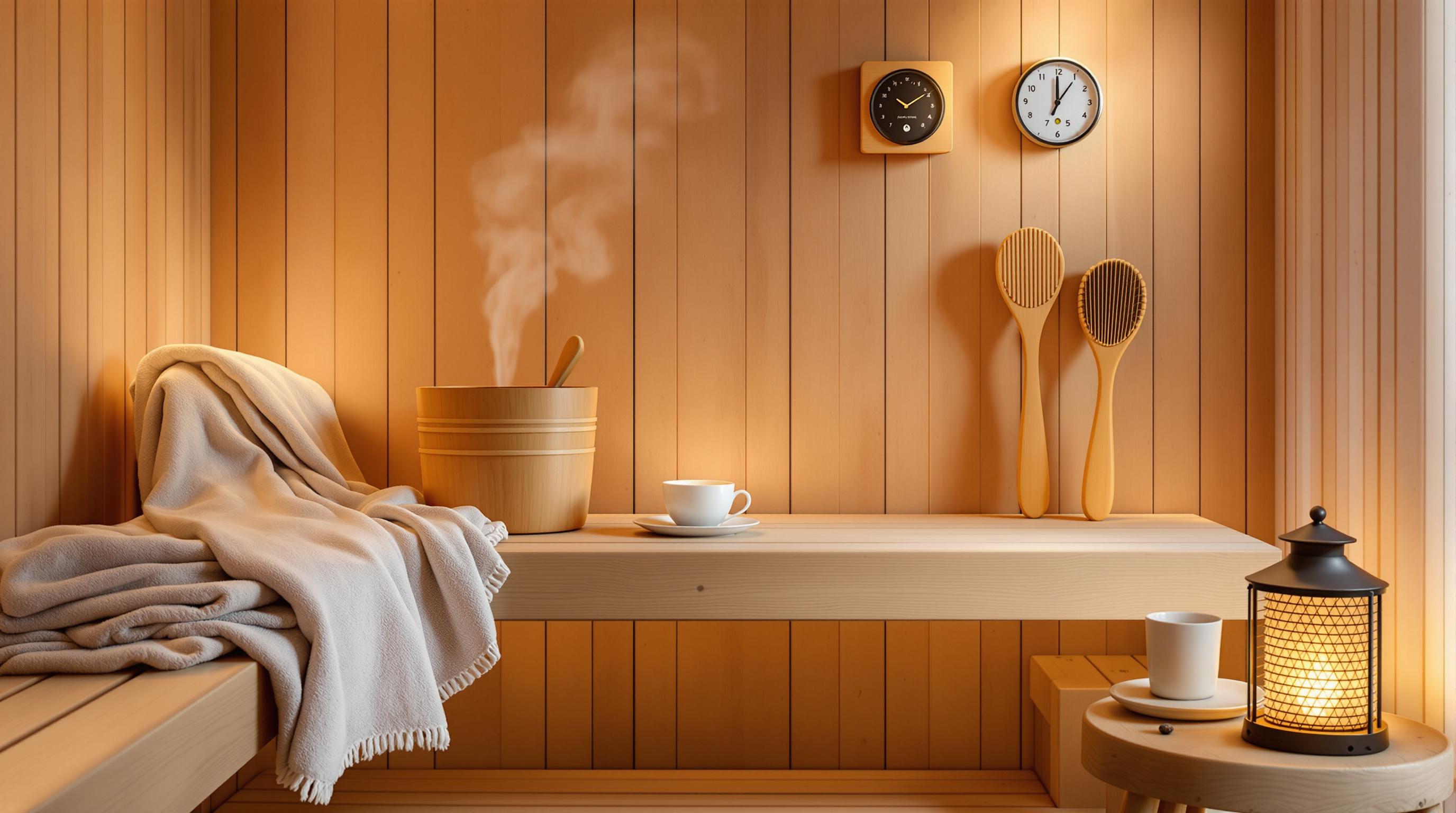Building a sauna in a humid environment? Here's what you need to know upfront: Cedar, Hemlock, Alaskan Yellow Cedar, and Aspen are the top wood choices for durability, moisture resistance, and mold prevention. Each has its own strengths, so your choice depends on priorities like cost, maintenance, and personal preferences. Here's a quick breakdown:
- Cedar: Naturally resists moisture and decay, with a strong scent and low maintenance needs.
- Hemlock: Affordable, smooth texture, and stable under humidity but slightly less durable.
- Alaskan Yellow Cedar: Highly moisture-resistant, durable, and eco-friendly but pricier.
- Aspen: Budget-friendly, hypoallergenic, and safe, though it requires sealing.
Quick Comparison
| Material | Durability | Mold Resistance | Water Resistance | Cost | Maintenance |
|---|---|---|---|---|---|
| Cedar | High | Excellent | High | High | Low |
| Hemlock | Medium | Good | High | Medium | Medium |
| Alaskan Yellow Cedar | High | Excellent | Excellent | Very High | Low |
| Aspen | Medium-High | Good | High | Medium | Medium |
Choose the wood that fits your budget and sauna needs, and always ensure proper installation and upkeep for long-lasting results.
Sauna Wood: Which Wood to Use in Your Sauna Project?
1. Cedar Wood
Cedar wood stands out as a top choice for saunas in humid environments, thanks to its ability to handle moisture and its long-lasting nature. These qualities make it a dependable option for building saunas that can endure high humidity.
Cedar naturally resists decay and holds up well under intense heat and moisture. Its natural oils not only help prevent mold and fungi but also repel moisture, reducing the risk of warping - an essential feature for steam saunas [1][2].
The wood's fine grain adds a touch of comfort and visual appeal. However, it may darken with prolonged exposure to heat [5]. Cedar's strong scent, released when heated, might not appeal to everyone. While it comes with a higher upfront cost, its durability often makes it a worthwhile investment [2].
| Cedar Wood Characteristics | Performance in High-Humidity Environments |
|---|---|
| Natural Oils | Resists moisture and decay naturally |
| Insulation Properties | Helps maintain steady sauna temperatures |
| Aromatic Quality | Emits a scent when heated (may be too strong for some) |
| Maintenance Needs | Requires little upkeep, occasional sauna oil treatment recommended |
To get the most out of cedar in humid conditions, experts suggest opting for cedar wood specifically treated for sauna use [4]. While cedar shines in durability and moisture resistance, other woods, such as hemlock, bring their own advantages to sauna construction.
2. Hemlock Wood
Hemlock wood is a smart choice for saunas in high-humidity environments. It handles moisture well and resists decay, which makes it a solid option for traditional steam saunas [1].
Performance and Protection
Hemlock stands out for its ability to manage moisture and resist decay naturally. Its low expansion and contraction rate keeps it stable, reducing the risk of warping or cracking even in fluctuating humidity. Plus, its structure helps lower the chances of mold growth, making it reliable for consistently damp conditions [2].
Texture and Comfort
Hemlock's smooth surface adds to its appeal, offering both comfort and safety. Its texture not only makes it functional but also enhances the overall look of the sauna. The wood’s natural appearance blends well with various sauna designs, making it a flexible option for different architectural styles [2].
| Characteristic | Performance Rating | Notes |
|---|---|---|
| Moisture/Durability | High/Medium-High | Sturdy but slightly less durable than cedar |
| Cost/Maintenance | High/Medium | Affordable but needs proper sealing |
Experts recommend using high-quality hemlock treated specifically for sauna use to get the best results in humid conditions [4]. Its natural insulating properties help maintain steady temperatures, and its affordability makes it a popular choice for both home and commercial saunas.
While hemlock offers a great mix of cost and performance, other options like Alaskan yellow cedar might be worth exploring for their distinct advantages in similar settings.
3. Alaskan Yellow Cedar
Alaskan yellow cedar, a type of Cypress, thrives in humid environments, making it a popular choice for sauna construction [1].
Durability and Strength
Thanks to its dense structure, Alaskan yellow cedar resists warping and cracking, even in high-humidity conditions [1]. This makes it a reliable option for saunas that need to endure moisture over the long term.
Water and Mold Resistance
This wood contains natural compounds that guard against mold and fungal growth - essential for keeping a sauna environment clean and healthy [1]. Plus, it doesn’t require chemical treatments, making it a more eco-friendly option.
| Property | Rating | Benefits |
|---|---|---|
| Moisture Resistance | Excellent | Minimal water absorption |
| Decay Resistance | High | Long-lasting durability |
| Heat Tolerance | Superior | Maintains integrity under heat |
| Mold Resistance | Excellent | Built-in anti-fungal properties |
Aesthetic Appeal and Texture
Alaskan yellow cedar stands out with its light color and unique grain pattern, adding a touch of sophistication to saunas. Over time, its natural yellowish hue develops a rich patina, enhancing its appearance while retaining its protective qualities. Its dense structure also allows for precise craftsmanship [1].
Temperature Performance
This wood handles heat exceptionally well, staying stable without discoloration or damage [1]. It also provides natural insulation, helping maintain consistent temperatures for a comfortable sauna experience.
Alaskan yellow cedar works well in both traditional and infrared saunas. However, its moisture-resistant qualities make it especially suited for traditional steam saunas [1]. While it comes with a higher upfront cost, its durability and low maintenance needs make it a smart long-term investment.
For a more budget-friendly option, Aspen wood offers its own set of benefits, making it worth considering as well.
sbb-itb-3953eb0
4. Aspen Wood
Aspen wood is a smart option for saunas, especially in high-humidity environments. It balances affordability with durability and moisture resistance, making it a great alternative to pricier materials like cedar and Alaskan yellow cedar.
Durability and Structure
Aspen is lightweight but dense, making it ideal for sauna construction. It holds up well under high heat and humidity, maintaining its structure and strength. This combination allows for intricate designs without compromising durability [1].
Natural Protection Features
Aspen wood offers natural defenses that address common sauna concerns. It is:
- Non-toxic
- Non-allergenic
- Resin-free
- Naturally resistant to bacteria [1]
These qualities make it a safe and health-conscious choice for sauna users.
Water and Moisture Management
Aspen's cellular structure resists swelling and handles moisture effectively, making it a reliable choice for steam saunas [1].
| Property | Performance | Key Benefit |
|---|---|---|
| Moisture Control | High | Reduces water absorption |
| Bacterial Resistance | Excellent | Naturally antimicrobial |
| Temperature Stability | Good | Maintains shape under heat |
| Maintenance Needs | Low | Easy to care for |
Aesthetic and Comfort Features
Aspen's light color and smooth grain give saunas a modern, inviting look. Its even texture feels comfortable to the touch and helps smaller sauna spaces feel more open [1].
Practical Considerations
Although aspen requires initial treatment and occasional sealing to keep its protective qualities intact [1], it works well in both steam and infrared saunas. Its cost-effectiveness and reliable performance make it a popular choice for home saunas.
Aspen offers a balance of safety, affordability, and functionality. But how does it stack up against other sauna materials? Let’s dive deeper.
Comparison of Pros and Cons
Choosing the right material for a sauna in humid environments involves weighing factors like durability, cost, and maintenance needs. Here's a breakdown to help guide your decision.
Material Performance Overview
Cedar is more expensive but lasts longer, while aspen offers a budget-friendly and dependable option. Hemlock balances affordability with solid performance, and Alaskan yellow cedar stands out for handling moisture well, though it can be harder to find.
Detailed Comparison Matrix
| Material | Durability | Mold Resistance | Water Resistance | Texture | Cost | Maintenance |
|---|---|---|---|---|---|---|
| Cedar Wood | High | Excellent | High | Coarse, Aromatic | High | Low |
| Hemlock Wood | Medium | Good | High | Smooth, Uniform | Medium | Medium |
| Alaskan Yellow Cedar | High | Excellent | Excellent | Dense, Fine | Very High | Low |
| Aspen Wood | Medium-High | Good | High | Smooth, Light | Medium | Medium |
Adapting to Humid Environments
Different woods respond uniquely to moisture. Alaskan yellow cedar is highly resistant to fungi and mold, making it a strong choice for wet conditions [1]. Cedar naturally repels insects and resists decay, maintaining its structure over time [2].
Cost-Benefit Breakdown
Higher-priced options like cedar and Alaskan yellow cedar offer long-lasting durability and require little upkeep. On the other hand, hemlock and aspen are more affordable while still delivering reliable performance.
Performance in High-Humidity Settings
| Feature | Cedar | Hemlock | Alaskan Yellow Cedar | Aspen |
|---|---|---|---|---|
| Moisture Management | Natural oils resist water | Good absorption control | Excellent water resistance | Effective moisture control |
| Heat Retention | Superior | Good | Excellent | Good |
| Structural Stability | High | Medium-High | Very High | High |
Safety and Comfort Considerations
Comfort varies by material. Cedar's aromatic qualities can enhance the sauna atmosphere, though some may find the scent overpowering. Hemlock offers a neutral choice with its smooth texture and mild aroma [2].
Ultimately, your decision will come down to balancing factors like durability, cost, and personal preferences for comfort and maintenance.
Final Thoughts
We've broken down the pros and cons of each material to make your choice easier.
- Cedar stands out for its durability and ability to resist moisture, though its scent might not appeal to everyone [2].
- Alaskan Yellow Cedar is incredibly durable and moisture-resistant, making it perfect for humid saunas, though it can be pricier and less accessible [1].
- Aspen is an affordable, hypoallergenic option with decent moisture control [1].
- Hemlock strikes a good balance between cost and performance, offering stability and moisture resistance, even in humid spaces [4].
Recommendations for Specific Needs:
- Alaskan Yellow Cedar: A top choice for durability, especially in humid conditions, though it’s less common and more expensive.
- Aspen: A budget-friendly option with hypoallergenic benefits.
- Cedar: Known for its natural antimicrobial properties.
- Hemlock: A dependable and affordable choice for consistent performance.
For more help choosing the right sauna materials and designs, check out Find the Home Sauna of Your Dreams at tophomesauna.com.
No matter which material you pick, proper installation and regular upkeep are key to keeping your sauna in top shape, especially in high-humidity settings [3].
FAQs
What is the least toxic wood for a sauna?
Basswood is a safe and hypoallergenic option for sauna construction, even in humid conditions. While it needs sealing and regular upkeep to handle moisture effectively, its qualities make it an appealing choice for those focused on health and comfort.
Here are some key benefits of basswood:
- Non-toxic
- Very mild scent
- Resistant to warping and cracking
- Soft and smooth texture
Unlike cedar or hemlock, basswood doesn’t have a strong aroma, making it ideal for individuals sensitive to smells. While it doesn’t naturally resist moisture as well as cedar or Alaskan yellow cedar, proper treatment allows it to perform well in humid environments [1].
When sealed and maintained correctly, basswood offers a durable, allergen-free option for saunas. Although it may not match the moisture resistance of some other woods, its safety features and comfort-focused properties make it a solid choice for your sauna project [2].


